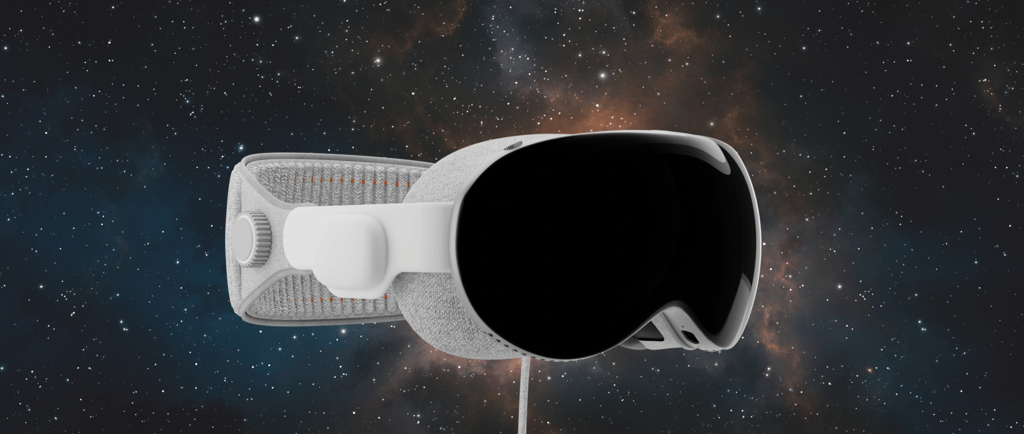Apple Vision Pro and the Beginning of the Spatial Computing Era
In 2025, spatial computing is no longer a futuristic concept but a tangible reality, and the Apple Vision Pro is one of the key players in this revolution. Launched in February 2024 in the United States, Apple's device, which the company insists on calling a "spatial computer" rather than a simple virtual or augmented reality headset, is redefining how we interact with technology. But what makes the Vision Pro so groundbreaking, and how is it paving the way for a new technological era? Let’s explore its features, impacts, and what this means for the future.
TECH TRENDS & INNOVATIONS


What is the Apple Vision Pro?
The Apple Vision Pro is a wearable device that blends elements of augmented reality (AR) and virtual reality (VR), but transcends these traditional categories. Powered by the visionOS operating system, it allows users to interact with digital content in a three-dimensional environment using natural inputs like eye movements, hand gestures, and voice commands. The device boasts an ultra-high-resolution display with 23 million pixels—more than 4K for each eye—along with advanced cameras, LiDAR sensors, and a dual-chip design (M2 and R1) that processes data in real time, ensuring a seamless and immersive experience.
Unlike other headsets, such as the Meta Quest, the Vision Pro isn’t limited to gaming or entertainment. It’s designed as a full-fledged computer, capable of replacing monitors, laptops, and even TVs in certain scenarios. For example, you can project multiple app windows around you, watch movies on a virtual 100-foot-wide screen, or work with life-sized 3D models, all while staying connected to your physical surroundings.
Spatial Computing: A New Frontier
Apple defines spatial computing as the intersection of the physical and digital worlds, where users can manipulate virtual content as if it were real. With the Vision Pro, this translates into an interface that "floats" in the space around you. Imagine opening Microsoft Word in a virtual window to your left, while a YouTube video plays to your right, and a 3D design project hovers in front of you—all controlled by your gaze and gestures.
This approach eliminates the constraints of traditional screens. Instead of being confined to a monitor, the Vision Pro offers an "infinite canvas," as Apple describes, allowing users to organize their workspace intuitively. This innovation has caught the attention of businesses and developers. For instance, KLM Royal Dutch Airlines uses the Vision Pro for its Engine Shop app, enabling technicians to overlay detailed 3D instructions onto real aircraft engines, improving maintenance accuracy and efficiency.
Impacts Across Industries
By 2025, the Vision Pro is already making waves in various sectors. In the corporate world, companies like SAP and Microsoft have integrated their tools with the device. SAP Analytics Cloud, for example, allows executives to visualize complex data in interactive 3D maps, enhancing strategic decision-making. Microsoft 365, with apps like Teams and Excel, offers an immersive productivity experience, where users can work across multiple virtual screens simultaneously.
In healthcare, the Vision Pro is being used for complex surgeries, such as mitral valve repairs, where doctors can project real-time tomography images around the patient. In education, teachers are creating immersive experiences, like 3D simulations of the solar system for students to explore. Even in retail, the device is transforming the shopping experience, allowing customers to visualize products in life-sized 3D before purchasing.
Challenges and Criticisms
Despite its potential, the Vision Pro faces hurdles. Its starting price of $3,499 makes it inaccessible to most consumers, with analysts predicting Apple will sell fewer than 1 million units in its first year. The battery life of just 2 hours (when not plugged in) also limits its portability. Major companies like Netflix, Spotify, and YouTube have yet to release native apps for visionOS, which may frustrate some users.
Additionally, the device’s weight and comfort during prolonged use have been criticized. Although Apple provides two headband options (Solo Knit Band and Dual Loop Band) for better fit, many users report discomfort after extended sessions. Privacy concerns also arise, as the Vision Pro collects detailed data about the user’s environment and movements. Apple will need to strengthen its data protection policies to address these issues.
The Future of Spatial Computing
The Vision Pro is just the beginning. By 2025, Apple has released updates like visionOS 2.4, introducing features such as natural language photo search and "Memory Movies"—spatial videos automatically generated from your photos. The company is also encouraging developers to create innovative apps, with over 1,000 native apps available shortly after launch, plus compatibility with thousands of iOS and iPadOS apps.
Looking ahead, spatial computing could fundamentally change how we work, learn, and connect. Imagine a future where augmented reality glasses replace smartphones entirely, or where 3D virtual meetings feel as natural as in-person gatherings. With Apple’s track record of turning emerging technologies into mainstream products—like it did with the iPhone—the company is well-positioned to lead this shift.
Conclusion
The Apple Vision Pro is more than a gadget; it’s a milestone in the dawn of the spatial computing era. Despite challenges like its price and technical limitations, it offers a glimpse into what’s to come: a future where the digital and physical seamlessly merge in intuitive and powerful ways. In the "Tech Alphabet" of innovation, the Vision Pro is the letter that opens a new chapter—and it’s up to us, as users and creators, to write the next pages. Are you ready to step into this new world?


